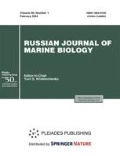Abstract
The effects of some hydrolytic enzymes from marine organisms on the formation and destruction of bacterial biofilms have been studied. As the results show, the presence of α-D-galactosidase from the marine bacterium Pseudoalteromonas sp. KMM 701 stimulates the growth of biofilms formed by various species of marine bacteria, whereas the formation of biofilms by Bacillus subtilis and Yersinia pseudotuberculosis is inhibited by this enzyme. Treatment with α-galactosidase causes destruction of 5 to 35% of a mature biofilm of various bacterial species. Phosphodiesterase and alkaline phosphatase from the marine bacterium Cobetia amphilecti KMM 296 have an inhibitory effect on the biofilm formation by marine strains of Bacillus licheniformis, B. aegricola, and B. berkelogi, and also degrade already formed biofilms of these bacilli and Yersinia. The crab hepatopancreas DNase inhibits the biofilm formation by Y. pseudotuberculosis and B. subtilis by partially degrading a mature biofilm.
Similar content being viewed by others
REFERENCES
Golotin, V.A., Balabanova, L.A., Buinovskaya, N.S., et al., Alkaline phosphatase from the marine bacteria Cobetia marina as a tool to study the properties of recombinant proteins, Vestn. Dal’nevost. Otd. Ross. Akad. Nauk, 2015, no. 6 (184), pp. 125–131.
Kuznetsov, V.G., Lazhentseva, L.Yu., Eliseikina, M.G., et al., Spreading of bacteria Yersinia genus in sea water and hydrobionts, Zh. Microbiol., Epidemiol., Immunobiol., 2006, no. 53, pp. 117–120.
Menzorova, N.I., Markova, A.V., and Rasskazov, V.A., Highly stable Ca, Mg-dependent DNase from red king crab hepatopancreas, Biokhimiya, 1994, vol. 59, pp. 449–456.
Romanova, Yu.M. and Gintsburg, A.L., Bacterial biofilms as a natural form of existence of bacteria in the environment and host organism, Zh. Microbiol., Epidemiol., Immunobiol., 2011, no. 33, pp. 99–109.
Slepchenko, L.V., Balabanova, L.A., Bakunina, I.Yu., et al., Properties and possible biological role of alpha-galactosidase from marine bacterium Pseudoalteromonas spp. KMM 701, Vestn. Dal’nevost. Otd. Ross. Akad. Nauk, 2017, no. 2 (192), pp. 51–58.
Somov, G.P., Modern views on sapronoses and saprozoonoses, Vet. Patol., 2004, no. 3, pp. 31–35.
Terentieva, N.A., Timchenko, N.F., Balabanova, L.A., and Rasskazov, V.A., Characteristics of formation, inhibition and destruction of Yersinia pseudotuberculosis biofilms forming on abiotic surfaces, Zh. Microbiol., Epidemiol., Immunobiol., 2015, no. 3, pp. 72–78.
Bakunina, I., Slepchenko, L., Anastyuk, S., et al., Characterization of properties and transglycosylation abilities of recombinant α-galactosidase from cold-adapted marine bacterium Pseudoalteromonas KMM 701 and its C494N and D451A mutants, Mar. Drugs, 2018, vol. 16, no. 10, art. ID 349. https://doi.org/10.3390/md16100349
Balabanova, L.A., Bakunina, I.Yu., Nedashkovskaya, O.I., et al., Molecular characterization and therapeutic potential of a marine bacterium Pseudoalteromonas sp. KMM 701 α-galactosidase, Mar. Biotechnol., 2010, vol. 12, pp. 111–120.
Balabanova, L.A., Golotin, V.A., Bakunina, I.J., and Rasskazov, V.A., Patent RU 2504583 C1, Izobret., Polezn. Modeli, 2014, no. 2.
Balabanova, L., Podvolotskaya, A., Slepchenko, L., et al., Nucleolytic enzymes from the marine bacterium Cobetia amphilecti KMM 296 with antibiofilm activity and biopreservative effect on meat products, Food Control, 2017, vol. 78, pp. 270–278. https://doi.org/10.1016/j.foodcont.2017.02.029
Costerton, J.W., Stewart, P.S., and Greenberg, E.P., Bacterial biofilms: a common cause of persistent infections, Science, 1999, vol. 284, pp. 1318–1322.
Fleming, D. and Rumbaugh, K.P., Approaches to dispersing medical biofilms, Microorganisms, 2017, vol. 5, art. ID 15. https://doi.org/10.3390/microorganisms5020015
Flemming, H.-C. and Wingender, J., The biofilm matrix, Nat. Rev. Microbiol., 2010, vol. 8, pp. 623–633.
Gilan, I. and Sivan, A., Extracellular DNA plays an important structural role in the biofilm of the plastic degrading actinomycete Rhodococcus rubber,Adv. Microbiol., 2013, vol. 3, pp. 543–551.
Lazar, V., Quorum sensing in biofilms – How to destroy the bacterial citadels or their cohesion/power?, Anaerobe, 2011, vol. 17, no. 6, pp. 280–285.
Nijland, R., Hall, M.J., and Burgess, J.G., Dispersal of biofilms by secreted, matrix degrading, bacterial DNAse, PLoS One, 2010, vol. 5, no. 12, art. ID e15668. https://doi.org/10.1371/journal.pone.0015668
Noskova, Y.A., Balabanova, L.A., and Terentieva, N.A., Alkaline phosphatase/phosphodiesterase from marine bacterium Cobetia amphilecti KMM 296, Vestn. Dal’nevost. Otd. Ross. Akad. Nauk, 2018, no. 6, suppl. 1, pp. 94–95.
O’Toole, G.A., Microtiter dish biofilm formation assay, J. Visualized Exp., 2011, vol. 47, art. ID e2437. https://doi.org/10.3791/2437
Römling, U. and Balsalobre, C., Biofilm infections, their resilience to therapy and innovative treatment strategies, J. Intern. Med., 2012, vol. 272, pp. 541–561.
Author information
Authors and Affiliations
Corresponding author
Ethics declarations
The authors declare that they have no conflict of interest. This article does not contain any studies involving animals or human participants performed by any of the authors.
Additional information
Translated by E. Shvetsov
Rights and permissions
About this article
Cite this article
Terenteva, N.A., Buinovskaya, N.S., Noskova, Y.A. et al. Hydrolytic Enzymes from Marine Organisms as Inhibitors of Biofilm Formation. Russ J Mar Biol 46, 302–305 (2020). https://doi.org/10.1134/S1063074020040094
Received:
Revised:
Accepted:
Published:
Issue Date:
DOI: https://doi.org/10.1134/S1063074020040094




